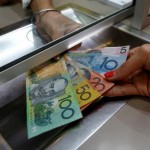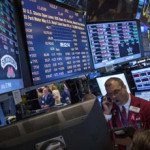Euro rose 0.1 percent, the sell-off stretched into Asia on Monday; What’s coming up this week

The sell-off that sent global markets into a tailspin last week stretched into Asia on Monday as investors continue to assess the impact that American protectionist policies will have on global growth. U.S. equity futures offered some hope of stabilization.
The steepest decline was in Shanghai with investors awaiting further developments on the U.S.-China tariffs. While stocks also declined in Tokyo, Hong Kong and Sydney, they were off the sessions’ lows. Shares rose in Seoul. Global stocks put in their worst week since the rout in early February and erased all of the subsequent recovery, with losses deepening into the close of Friday trading in the U.S. Futures on the S&P 500 Index and the Nasdaq advanced.
The yen slipped back from the strongest in more than 16 months against the dollar. The dollar was weaker against all major peers except the yen.
“There’s a lot of uncertainty right now,” Oliver Pursche, chief market strategist at Bruderman Asset Management, told Bloomberg TV. “Over the next week or two, investors should be prepared for more volatility but should also be looking out for some great companies that are going to be available to buy at very, very good prices.”
Treasury Secretary Steven Mnuchin told Fox News that he’s “cautiously hopeful” the top two economic powers will reach a deal to avoid the tariffs U.S. President Donald Trump ordered on at least $50 billion of Chinese imports. Part of the problem for investors is assessing how the tariffs will be implemented, particularly after Trump exempted a handful of key partners from planned steel and aluminum tariffs.
Mnuchin’s comments came after the administration announced a deal with South Korea that he said would limit the amount of steel imported into the U.S.
While this week may remain volatile as investors tweak portfolios prior to the end of the first quarter in shortened trading for many markets due to the Easter holiday, some say the sell-off is overdone. Market conditions are looking favorable heading into the second quarter and asset allocations should remain oriented toward growth, according to JPMorgan Chase & Co.
Elsewhere, crude oil fell after its biggest weekly gain since July. China launched its first ever crude-futures contract. The yuan-denominated futures on the Shanghai International Energy Exchange traded at 432.2 yuan a barrel ($68.48) for September settlement at 9:45 a.m. local time.
Here’s a list of what’s coming up this week:
- U.S. personal income and spending data for February, coupled with the Fed’s favored inflation gauge are the key pieces of U.S. data. Income and spending are forecast to grow at the same pace as
- January but consensus sees the core PCE deflator picking up to 1.6 percent from 1.5 percent.
- This week’s European economic agenda is highlighted by March CPI readings in the big four euro-area economies and output data for the U.K. Headline inflation probably ticked up in Germany,
- France, Spain and Italy. A third estimate of U.K. GDP is set to confirm growth of 0.4 percent in the fourth quarter.
- The U.S. Treasury will probably auction about $294 billion of bills and notes this week, its largest slate of supply ever.
And these are the main moves in markets:
Stocks
- Japan’s Topix index declined 0.5 percent as of 2:16 p.m in Tokyo. It fell as much as 1.2 percent earlier.
- Australia’s S&P/ASX 200 Index lost 0.5 percent.
- South Korea’s Kospi index rose 0.3 percent.
- Hong Kong’s Hang Seng Index fell 0.7 percent.
- Shanghai Composite Index lost 1.3 percent.
- The MSCI Asia Pacific was down 0.4 percent after falling 3.5 percent last week.
- Futures on the S&P 500 Index added 0.6 percent. The underlying measure dropped 2.1 percent on Friday, bringing its weekly slide to 6 percent.
Currencies
- The Bloomberg Dollar Spot Index fell less than 0.05 percent.
- The euro rose 0.1 percent to $1.2370.
- The pound traded at $1.4158, up 0.2 percent.
- The yen weakened less than 0.2 percent to 104.90 per dollar, edging back from the strongest in more than 16 months.
Bonds
- The yield on 10-year Treasuries rose more than one basis point to 2.83 percent.
- Australia’s 10-year bond yield was steady at 2.65 percent.
Commodities
- West Texas Intermediate crude lost 0.4 percent to $65.63 a barrel.
- Gold was little changed at $1,346.82 an ounce, around the highest in more than a month.
Source: Bloomberg – Stocks Drop in Asia on Trade; S&P 500 Futures Rise: Markets Wrap





























